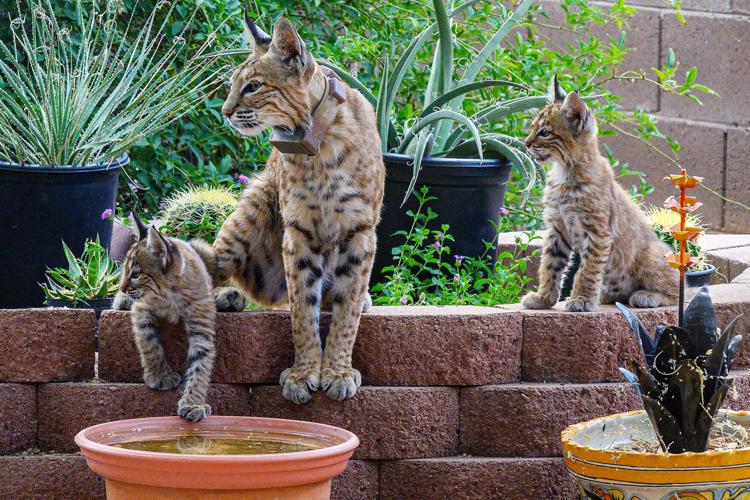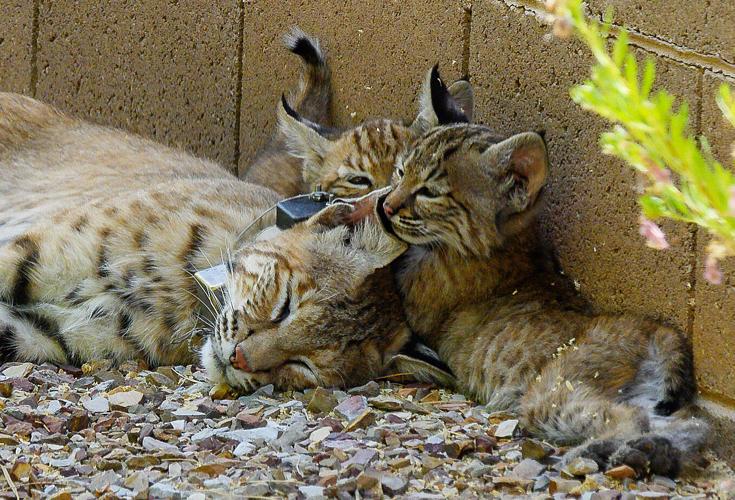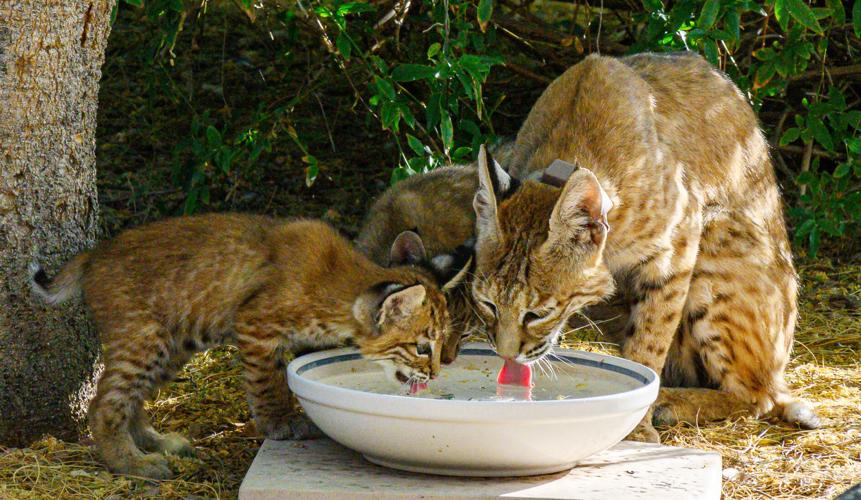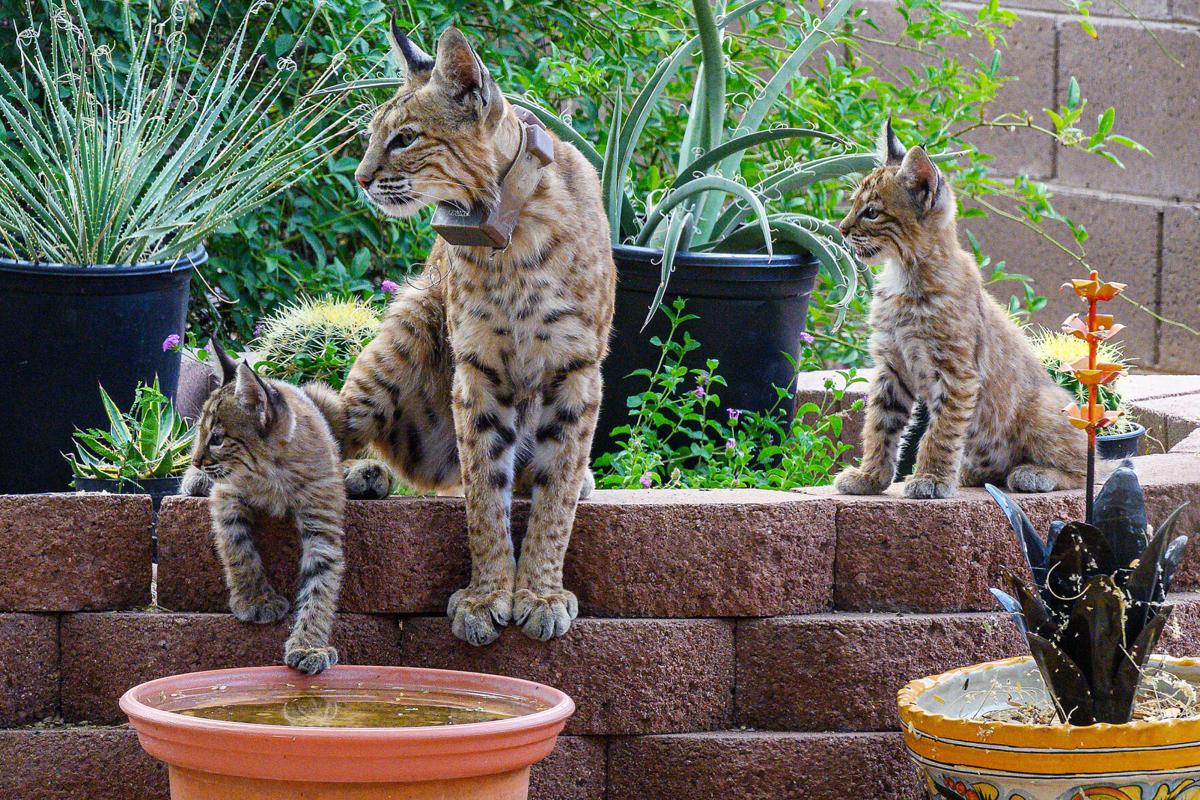Biologists studying the behavior of urban bobcats on Tucson’s west side have hit the mother lode with Avery.
The large female has spent the past several months raising two kittens in a gated community near Sweetwater Drive and Camino de Oeste, where researchers have been following her every move thanks to the GPS collar around her neck and the army of enthusiastic residents looking out for her.
Avery and her kittens have been lounging in backyards and hiding out on rooftops at about a half-dozen homes in the Rancho Agua Dulce subdivision. They’re still there now, according to the latest tracking data from the Bobcats in Tucson Research Project.
It’s just the sort of thing Cheryl Mollohan was hoping to document when she launched the project in 2020 to study what some experts have called the highest concentration of urban bobcats anywhere in the United States.
“This is exactly what I was after, because it’s so unique that (bobcats) have infiltrated so far into Tucson,” Mollohan said. “This has been a wild ride.”
Avery was trapped by the research team and fitted with a tracking collar on Jan. 14, just across Sweetwater Drive from Rancho Agua Dulce.
The mature female, probably 3 to 5 years old, weighed 23 pounds at the time, a full 6 pounds heavier than any other female in the study. The on-site veterinarian soon discovered why: Avery was pregnant out of season, which Mollohan said usually only happens to bobcats that lose their kittens the previous spring.
Tracking data suggests the cat gave birth about a week after she was captured. She’s been moving around the gated community with her kittens ever since.
“She lives there. That’s her home,” Mollohan said.

Avery and her kittens have been moving from house to house in the Rancho Agua Dulce subdivision on the west side of Tucson.
Hairy disclosure
Avery is part of a new round of bobcat captures meant to collect data from animals living closer to the city, without ready access to large areas of natural habitat.
By contrast, the bobcats caught and collared during the first year of the study mostly came from the western fringes of town, where homes are easier to avoid and the Tucson Mountains are never far from reach.
Mollohan said those cats seem to use residential neighborhoods differently than the more urban animals do. Though they will lounge in a backyard or drink from a swimming pool on occasion, when the time comes to have their kittens, they all retreat into the foothills to set up their dens in the steepest, nastiest terrain they can find.
Avery had no such option, so she gave birth in a secluded spot along the natural wash that runs through Rancho Agua Dulce, then moved her newborn kittens from hiding place to hiding place, sometimes carrying them one at a time across distances of up to half a mile.
Once she got them tucked away somewhere safe, she would leave them alone, sometimes for hours at a time, to go looking for food.
“She was literally stashing them under a bush” or in a pile of palm fronds and other yard debris that had been dumped in the wash, Mollohan said. “It’s been harrowing to watch, because you can’t do anything to help her.”

Avery, a mature female, is probably 3 to 5 years old. When she was trapped by a research team in January, she weighed 23 pounds, a full 6 pounds heavier than any other female in the study. The on-site veterinarian soon discovered why: Avery was pregnant out of season.
After about two months of this, the bobcat hauled her kittens out of the wash and into the neighborhood, where she briefly settled with them among the gabled-roof tiles of a vacant house on Bear Spring Trail.
Realtor Heather Shallenberger said it was the first time in her 24 years of selling homes in Tucson that a wild animal nearly derailed a sale.
She said the Shallenberger Team at Long Realty was holding an open house at the property when Mollohan showed up to tell them about the bobcat family and ask if she could put up some trail cameras to try to record the cats coming and going.
That decision soon fell to the prospective buyers of the $431,000 home. Shallenberger said the buyers’ agent was “a little bit freaked out at first,” because her clients have smaller dogs and didn’t want to lose one of them to a predator on their roof.
“Everytime you think you’ve seen it all, and then you find out that a bobcat could be an issue,” Shallenberger said.
Mollohan and company eventually calmed the buyers’ fears and got them to agree to put the cameras up, but Avery had other ideas. A short time later, she gathered her kittens and moved on, possibly spooked by the presence of a crew brought in to install new windows at the house.
Shallenberger said she and her team never laid eyes on the cats outside of pictures captured later by other people in the neighborhood. “We were kind of bummed we didn’t get to see them,” the Tucson native said.

A bobcat and her kittens drink water in the backyard of a home in a gated community near Sweetwater Drive.
Backyard show
The bobcat family’s next stop was a rooftop two houses away, where Mollohan said they stayed for the next six weeks or so.
Homeowner Kom Loh said he never heard them and had no clue they were up there until they climbed down into his backyard in mid-May. He got to watch them in his yard for a few days, before the feline family moved on to another nearby house and then another.
“It had been my privilege to be the unwitting host to Bobcat Avery and her kittens,” Loh said in an email. “Bobcats are magnificent animals, and I am glad to have encountered them.”
Chris Wesselman and his wife, Sue Pulk, got their turn with Avery about a month ago.
She and her kittens spent four mornings in the Wesselmans’ backyard, where Chris, a self-described “advanced amateur photographer,” took pictures of the cats as they played, drank from water bowls and devoured a dove brought home by mom.

A bobcat and her kittens lounge around and explore the backyard of a home in a gated community near Sweetwater Drive and Camino de Oeste in June. The adult cat, nicknamed Avery, was fitted with a tracking collar as part of a study of the animals on the west side of Tucson.
Chris Wesselman said they were a little worried about the cumbersome-looking collar on Avery at first, but they felt better about it after Sue looked up the research project’s website and made contact with Mollohan.
“It was just exhilarating to see them right there in the backyard,” he said. “They’re amazing to watch.”
Observing the bobcat family has been educational, too, even for an experienced biologist like Mollohan.
She said Avery maintains the largest home range of any female in the study — hunting across an almost 5-square-mile area — but she has chosen to raise her kittens in one of the most densely populated parts of her territory.
One reason why could be the way Rancho Agua Dulce was built. The subdivision includes numerous desert green spaces developed around the natural wash corridor that runs diagonally through the property.
As for all the houses, Mollohan said Avery seems to treat them no differently than the natural features she might find in the open desert.
“She is in the midst of all these rock piles. They just happen to have humans living in them,” the researcher said. “She uses what’s available to her, and in this case it’s houses.”
But while Avery seems to tolerate proximity to people, she certainly doesn’t welcome it. “She doesn’t like disturbances, even though (she and the kittens) are on a roof in the middle of a subdivision,” Mollohan said.
People looking at her from inside of a house doesn’t seem to bother her. But if you go outside and make eye contact, that seems to unsettle her, Mollohan said. Sometimes that’s all it takes to convince Avery it’s time to move on.
Researchers and residents get a look at how an urban bobcat raises her young.
So far, though, she hasn’t strayed very far.
Mollohan said the cat has been bouncing around inside the subdivision for so long now that the homeowners association decided to give researchers the gate codes so they could access the community as needed.
“People have been so helpful,” she said, which doesn’t surprise her a bit. She already knew that about the Old Pueblo before the study even started.
“I personally believe Tucson is a very tolerant town, and people are remarkably willing to share their environment with bobcats and other wildlife,” Mollohan said. “I think that’s the reason we have what we have here.”
Photos: Suburban bobcat sightings around Tucson
Suburban bobcat sightings
Updated
The babies were fooling around with the desert tortoise but luckily soon lost interest. He was fine.
Suburban bobcat sightings
Updated
David Burford snapped some photos of a mama bobcat and her three kittens in the backyard of his Oro Valley home.
Suburban bobcat sightings
Updated
Victor Sunstar spotted bobcats in his yard almost every morning.
Watch Now: Collared bobcat raises kittens in Tucson neighborhood
UpdatedResearchers and residents get a look at how an urban bobcat raises her young.
Suburban bobcat sightings
Updated
This bobcat watched as Sherri Brean took its photo March 3, 2022, at a house near Oro Valley.
Suburban bobcat sightings
Updated
On March 3, 2022, Arizona Daily Star reporter Henry Brean caught the same bobcat taking a nap.
Bobcat plays with its kitten in Tucson backyard
UpdatedTucson wildlife: A bobcat and its baby were caught on camera multiple times playing together in a backyard on Tucson's southeast side this weekend. These desert cats were seen on June 11 and 12, between 5 and 6 a.m., by Tucson resident Tracie Robbins, who shared the videos on Twitter.
"We may not see a bobcat for months, and then sometimes we’ll have visitors for several days in a row," Robbins said. She said she noticed a basket of golf balls tipped over when she woke up and took that as a sign that the cats routinely stop by to visit and play on the putting green outside. Video courtesy of Tracie Robbins.
Suburban bobcat sightings
Updated
Bobcat kitten on the wall
Suburban bobcat sightings
Updated
Bobcat found a warm, dry place to nap on our patio during the rain.
Watch now: Bobcat's breakfast near Oro Valley
UpdatedWatch as this bobcat stalks his prey and then catches it. Let this remind you not to leave small pets outside unattended. Video by Sandra McCauley.
Suburban bobcat sightings
Updated
Bobcat moments before his kill of a ground squirrel
Suburban bobcat sightings
Updated
Bobcat kittens in a tree
Watch now: Family of bobcats spotted in Foothills back yard
UpdatedThree bobcats were filmed Jan. 2 passing through the back yard of a home in the Catalina Foothills just before sunset.
Jennifer Perez, who recorded the video of the feline trio and shared it on social media, said she often sees wildlife enter her yard from a deep wash located behind it. One bobcat shown can be heard softly growling around 30 seconds into the video. Video courtesy of Jennifer Perez.
Suburban bobcat sightings
Updated
Young Bobcats drinking. Mom is nearby.
Suburban bobcat sightings
Updated
This bobcat was spotted drinking out of our fountain
Suburban bobcat sightings
Updated
Taken in Oro Valley
Watch now: A conversation between bobcats in the Tucson area
UpdatedJennifer Perez calls the female bobcat Sheba and the male Zeus. Zeus made his way over to have a drink of fresh water and Sheba went over behind him. When both of them were at the dish Zeus showed his dominance and Sheba became submissive. Video by Jennifer Perez.
Suburban bobcat sightings
Updated
A courageous bobcat atop a Saguaro.
Suburban bobcat sightings
Updated
Mike Klinicki took this photo at his home on June 2015. "We discovered bobcats living on our roof after hearing some noise several nights in a row. We live in Vail. There was a mother and three cubs."
Suburban bobcat sightings
Updated
We have had lots of bobcat visitors around here. My favorite is when there is a mama with her babies.
Watch now: Bobcat vs. snake in Tucson yard
UpdatedA bobcat kitten found a snake in the backyard of a Tucson home and couldn't resist a tussle. The bobcat was born several months prior near the home. Video by Eric Schaffer.
Suburban bobcat sightings
Updated
Jim Liessmann took this picture on April 30, 2008, of a bobcat on a saguaro.
Suburban bobcat sightings
Updated
Gay Russell took this photo in June 2011. "After several days of resting and playing in my yard, a mother bobcat left her two kittens, about a month old, with me while she went hunting. I was able to catch this photo of one of the kittens, playing peek-a-boo! "
Watch now: Bobcat stops by Tucson waterhole for an overnight drink
UpdatedThis thirsty bobcat was filmed drinking from a well in a Catalina Foothills resident's back yard Saturday, July 9. "Fred" the bobcat is a regular visitor to this waterhole. Video courtesy of Yessica Wheeler.
Suburban bobcat sightings
Updated
"Fred" the bobcat sits in front of cactus in a Catalina Foothills resident's back yard.









